Otto I
and the
Holy Roman Empire
|
The vacuum in the Carolingian East left by Louis the
Child's death had been
solved by the election of Henry the Fowler to become
King of Germany. Now the transition to a new order was complete
and the Carolingian Empire was officially over.
The choice of Henry to take Conrad's place
heralded the beginning of the Ottonian dynasty.
Henry's son Otto I (912–973) inherited the Duchy of
Saxony and the kingship of the Germans upon his father's
death in 936.
Otto
the Great would reign as German king from 936 until his
death in 973. Otto proved to be a competent ruler. Once he solidified
his role as King of Germany, this meant the split between
East and West Francia was complete and irreversible.
Otto continued his father's work to unify all German tribes
into a single kingdom. He greatly expanded the king's powers
at the expense of the aristocracy. Through strategic
marriages and personal appointments, Otto installed members
of his own family to the kingdom's most important duchies.
This reduced the various dukes, who had previously been
co-equals with the king, into royal subjects under his
authority. Royal subjects maybe, but Loyal subjects
no. The bitterness they felt would be reflected in a
thousand year dance - the princes of Germany would always
deliberately keep their king weak for fear that a strong
king would curtail their influence.
|
Otto's next move was to transform the Roman Catholic Church in
Germany to strengthen the royal office and subjected its
clergy to his personal control. Otto then suggested to
the Pope that the church align itself with his powerful
kingdom.
The coronation of Otto I by Pope John XII in 962
marked a revival of the concept of a Christian emperor in
the west. Otto become the leader/founder of the Holy
Roman Empire when he was crowned emperor. Otto
fashioned himself as the "successor of Charlemagne".
Some historians refer to the coronation of Charlemagne as
the origin of the HRE, while others prefer the coronation
of Otto I as its beginning. If one dates the
start of the HRE to Charlemagne, it enjoyed a
Thousand Year run. If one dates the start to Otto I,
it was the beginning of an unbroken line of Holy Roman
emperors lasting for more than eight centuries.
Thanks to Charlemagne, the HRE had started in West Francia.
However, the coronation of Otto meant the center of
the HRE had flipped to East Francia, aka the
Kingdom of Germany.
The Kingdom of Germany and the HRE would
remain loosely synonymous for the next 800 years until its
dissolution in 1806 thanks to the decision of Napoleon. Although
the HRE included at times the Kingdom of
Italy, the Kingdom of Bohemia, and the Kingdom of Burgundy,
the core and largest
territory of the empire was always Germany.
Otto I, his son Otto II and grandson Otto III each
regarded the imperial crown as a mandate to control the
papacy. They dismissed popes at their will and installed
replacements more to their liking. This power, together
with territories covering much of central Europe, gave the
German empire and the imperial title great prestige in the
late 10th century.
But subservience was not what the Pope had in mind when the
Pope John XII reinstated the Holy Roman Empire.
Over the next eight centuries, there would be many showdowns.
Here in America, our founding fathers had the wisdom to keep
the church and the state separate. The Europeans had
no such luck. Politics are difficult enough as it is,
but when religion becomes intricately entwined with
politics, things can get very confused.
The power struggles between the various Kings of Germany, aka the
"Emperors of the HRE" and the various popes over the
centuries helped turn Germany into a complete mess.
|
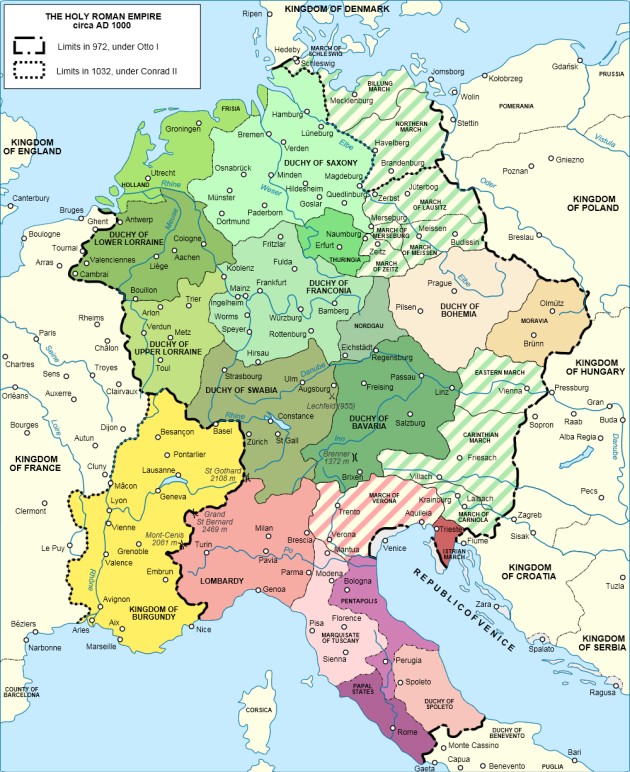
The
Holy Roman Empire began in 962 and ended in 1806. In
this snapshot from 1000 AD, one can see the rough outline of
today's modern German nation.
|
Weakness of
the Emperor
|
So what exactly was the
Holy Roman Empire?? Good question, but very tough to answer.
The Holy
Roman Empire was a strange political
entity.
The HRE
was not a highly centralized state like most
countries today. Instead, the HRE came to be
divided into dozens — eventually even HUNDREDS — of
individual political units governed by kings,
dukes, counts, bishops, archbishops, abbots, and
princes.
Strangely
enough, the German people came up with a system
where the King of Germany was "elected".
Has anyone ever heard of a King being elected?
It started when
the throne of East Francia was vacated with no valid
heir. Once Louis the Child died, that
forced the Princes, the rulers of the duchies and
therefore the next level of power in Germany... to
pick someone to be their ruler.
After Conrad
of Franconia was
ELECTED
to take the place of Louis the Child, this
set the precedent to
ELECT
Henry the Fowler as well. From that
point on, unlike the Kings of other European countries who simply
inherited the crown, a German King had to be
"elected" to office by a council of elite German princes.
After Otto
the Great ran roughshod over the Princes, they
thought twice about this new system. The
German Princes decided amongst themselves that
limiting the powers of the "King" was in their own
best interests. One needs to remember that all
people fear the rule of tyrants. For example,
the main reason Julius Caesar was assassinated was
due to fear over his increasing power.
So the German
Princes made sure each new King would maintain the
decentralized system of states in Germany.
|
This odd
circumstance did indeed keep the Kings from being
more powerful than the Princes, but it was
unfortunate for the Kingdom of Germany because it
guaranteed the country would never become "unified".
Since Otto's
original idea was
to align East Francia with the Catholic
Church, the
new "Emperor" was usually German. Once
the new German
king was chosen, the current Pope would then
coronate the new king as the new Holy Roman Emperor.
The same lack
of real authority spilled over to the position of
"Holy Roman Emperor". After the new German
monarch realized he was in a restricted position as
the "King", he would discover his position as "Holy
Roman Emperor" was not very powerful either.
If anything,
interference from the Church made governing Germany
even harder. As time passed, the authority of
the "King and Emperor" to govern grew weaker and
weaker.
The Emperor was
expected to protect the Pope and the Church. Unfortunately,
over the 8 centuries of the HRE, the Emperor
would usually spend more time arguing with the
Pope than anything else.
|
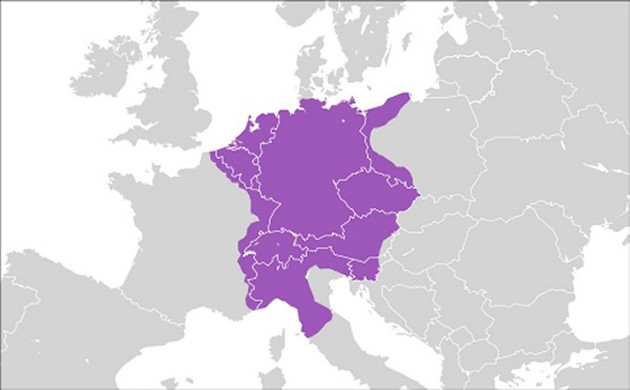
The
Holy Roman Empire changed shape many times during its eight century
run with different territories coming and going, but the
Kingdom of Germany was always at the core. Since the
Emperor was typically "German", Germany and the HRE became
roughly synonymous.
|
Simony and the
Investiture Controversy
|
|
There is a legend that the Founding Fathers of America
studied the history of Europe carefully so they could avoid
the mistakes of the European political systems. Two
features in particular were changed. There would be no
kings... America would be a democracy... and there would be
no religious interference in matters of government (or vice
versa).
Surely the story of the power struggles between the Roman
Catholic Church and the Holy Roman Empire was the major
reason that led to the
decision to keep the Church separate from the State here in
America.
Medieval times were often called the "Dark
Ages" for a reason. There were incredibly cruel and
horrible things done that defy understanding. Not that
we have evolved all that much... there is still war, murder
and corruption aplenty going on today. Nevertheless,
many things were done back in those days that we would term
"excessive" now.
|
Anyone who has studied the history of the Roman Catholic Church knows full
well there are shameful stories aplenty.
In particular, many of the abuses - genocide against people
of other religions, torture - were
done either by the Church itself or by representatives
acting in the "Name of God". "Spanish
Inquisition", the suppression of knowledge
(think Galileo), and the Crusades are prime examples.
On the other hand, the Roman Catholic Church has done a
great deal of good as well. The Church has played an
enormous role in bringing the valuable teachings of Jesus to
the Western Civilization.
The Church took a noble stand against slavery.
And many times it was the Church who protected the weak by
acting as the only check on the abuse of powers by evil
kings. When it came down to abuse of powers, there
have been some European rulers who would have stopped at
nothing were it not for the Church standing in their way.
The Holy Roman Empire was fertile ground for power struggles
between the Church and the German rulers. There were
all kinds of inherent conflicts built into the system.
The story of the 800 year Holy Empire could be boiled down
to a three ring circus between the Pope, the Holy Roman
Emperor, and the German princes who learned to gang up on
whichever side was not currently acting in their preferred
interests.
When Otto I got
himself declared "Holy Roman Emperor" in 962, he
fully expected to have his way with the Popes.
|
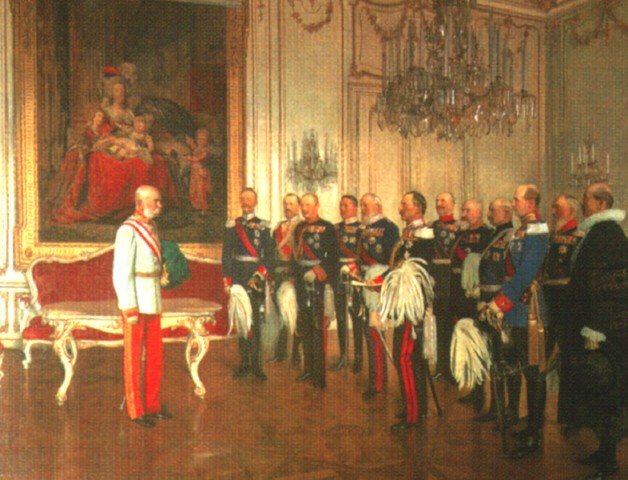
German
Princes making their wishes known to the Emperor. For
the entire reign of the Holy Roman Empire, by pursuing their
own individual interests, it was the German princes who
played a key role in limiting the Emperor's authority and
keeping Germany divided.
|
And that is
pretty much how it went down at first.
The Emperors had
their way with the Popes for the first hundred years
of the system put in play by Otto I. The
Church was rich beyond belief and the Emperors
exploited the wealth any way they could.
One of their
favorite tricks was Simony. Simony was the
act of selling church offices and roles.
Since a
substantial amount of wealth and land was usually
associated with the office of a bishop or abbot,
the sale of Church offices (a practice known as
simony) was an important source of income for
leaders among the nobility. It wasn't just the
nobility who owned the land. By charity, the
nobility donated the land that allowed the building
of churches and cathedrals. After that, the Church
owned the land. Over time, the Church had acquired
extensive property of its own and had grown greatly
in power.
The Church was
able to place itself in the middle of all affairs in
the daily life of the people. Frequently the
bishops were regarded for legal purposes as lords,
and some bishops had extraordinary political powers.
They made many daily decisions that greatly affected
the business practices and personal lives of the
people in their realm. In addition, some
bishops even had the power to decide who the next
Emperor would be. For example, three bishops
were among the seven men who elected emperors of the
Holy Roman Empire.
The result was
that the nobles as political authorities saw great
importance in having bishops who were politically
aligned with their interests. There had always
been a principle that the Church chose its own
bishops.
The purchase
of ecclesiastical authority was a sin called "simony".
And why was it
a sin??
In a nutshell,
the widespread practice of Simony deprived the Popes
of much of their authority.
Since priests
who were outside the ruling nobility did not earn
substantial wealth or have the ability to pass their inheritance on,
they would be difficult to sway by greed and power.
Their decisions would be fair and their jobs
would depend on answering to the Pope.
On the other
hand, it was beneficial for a ruler or nobleman to
appoint or sell the office to someone who would be
"loyal", which is another way of saying maybe the
people he appointed would be willing to let the
ruler get away with murder... literally.
Even before
Otto came along, the practice of simony became
widely accepted, sin or no sin. As we saw in
the crazy tale of Lothair II, Hucbert, the brother
of Teuberga, was not only a sinning,
bullying soldier, he just happened to also be an
abbot . Ghunter and Thietgaud, the men who
presided over the trial of Teutberga, were not only
Archbishops, they were also relations
of Waldrada. These men had all purchased
their positions of authority within the church.
The story of
Hucbert et all shows the practice
of simony was well-entrenched even before
Otto came along to reestablish the position of Holy
Roman Emperor.
Otto I
versus Pope John XII
Otto added a
new feature. Otto made sure the Emperor chose
the Pope and not vice versa. The Pope-elect was
required to issue an oath of allegiance to the
Emperor before his confirmation as Pope. If
the Emperor didn't like the Pope, he would get rid
of him.
Almost
immediately, Pope John XII regretted his decision to
empower Otto. He began to fear the Emperor's
rising power in Italy and began secret negotiations
a nobleman named Berengar to depose Otto. The
Pope also sent envoys to the Hungarians and the
Byzantine Empire to join him in an alliance against
the Emperor. Otto discovered the Pope’s plot and,
after defeating and imprisoning Berengar, marched on
Rome.
John XII fled
from Rome, and Otto, upon his arrival in Rome,
summoned a council and deposed John XII as Pope,
appointing Leo VIII as his successor.
Otto returned to Germany by the end of 963,
confident his rule in Italy and within Rome was
secure. However, the moment he was gone, John
XII began stirring up trouble behind him. The
Roman populace considered Leo VIII, a layman with no
former ecclesiastical training and loyal to Otto,
unacceptable as Pope.
In February
964, at the provocations of John XII, the Roman
people forced Leo VIII to flee the city. Leo VIII
was deposed and John XII was restored to the chair
of St. Peter.
When John XII
died suddenly in May 964, the Romans elected Pope
Benedict V as his successor.
Upon hearing of
the Romans’ actions, Otto mobilized his army and
returned to Italy. After marching on Rome and laying
siege to the city in June 964, Otto compelled the
Romans to accept his appointee Leo VIII as Pope and
exiled Benedict V.
Otto had proven
who was in charge. He had the army.
Whatever Otto wanted, Otto got.
If Otto wanted
the practice of simony to continue, then it would
continue. The consequence was that now bishops
and abbots continued to usually part of the ruling
nobility themselves.
The German Princes
The practice of
simony posed a real problem for the Pope. It
meant that practically every appointment on his
staff was out of his control. It meant that
most of his administrative staff was more loyal to
the Emperor or to local nobles than to him.
Although
history typically concentrates on the key players
such as the Holy Roman Emperor and the Pope, the
German princes, aka "the nobility" were actively
involved in the ongoing conflicts.
The fascinating
thing about this whole scenario is that the nobility
was just as much a player as the Emperor and the
Pope. Because both the Emperor and Pope were
elected positions, once the nobility discovered that
they had quite a bit of say-so in which particular
man got elected and which didn't, they turned into
spoiled brats. Like kids
who play Mom and Pop against each other, over time
the nobility found that they had the ability to get
what they wanted by exploiting the vulnerabilities
of the men who wished to occupy vacancies in the seat of power.
The practice of
simony was of extreme importance to both the Emperor
and the nobles. Not only could a King or a noble
acquire large sums of money from selling high church
appointments, he could put friends in high places
who were loyal to him.
The nobility
developed a clever trick. Literacy was a
pre-requisite to obtaining a church appointment.
However, education was also quite rare in those times. So the nobles
developed a system whereby the older siblings in the
family would inherit the land and titles while the younger sons
of the nobility were assigned the task of learning to
read and acquire religious training. When the time
came, someone in the family would be prepared to be
appointed as bishop or abbot.
As one might
gather, there was a huge premium on having big,
strapping healthy boys. Only boys could be
kings. Only boys could be warriors. Only
boys could find positions of importance in the
Church. Only boys could inherit lands.
People died
young in those days. Life spans weren't very long. The
big problem was that disease held a vastly upper
hand to knowledge. Sanitation was poor.
Plague was a constant threat. Infection was a
danger. One fever could end things quickly.
Therefore everyone wanted
to have lots of boys in case
some of them died in war or to disease.
Furthermore,
having children was a real headache. As we saw
in the case of our friend Teutberga coming up
barren, many arranged marriages saw men trapped to
women who could not bear children. For
example, Anne of Austria, wife to France's Louis
III, spent twenty-three years of marriage trying to
produce an heir. After four miscarriages, Anne
finally gave birth to a son, the future Louis XIV.
The birth was considered a "miracle" at the time,
but more likely Anne discretely switched to another
man in her desperation to fulfill her duty.
Giving birth
was serious business. Due to poor sanitary habits, child birth often resulted in the death of
the child or death of the mother or both. Furthermore,
having a healthy, intelligent boy was a lot harder
than one might imagine. The health of the
child was never taken for granted. Due to
ignorance about the dangers of inbreeding, cousins
married all the time. The result was that many
royal
children were sickly, deformed, and oft times moronic.
The Church didn't make
things any easier by prohibiting divorce (e.g. Henry
VIII of England and his shenanigans of getting rid of one wife
after another trying to have a male heir).
Bottom Line: Due to the
difficulty having a healthy male child with a good head
on his shoulders, hereditary lines died out all the time.
For example, Otto I
became Emperor in 962. He was
succeeded as Emperor by Otto II by Otto III by
Henry
II and then his line died out in 1024. Four
men lasted a sum total of of 42. Men simply
didn't live very long in those days. In only
42 years, the line established by Otto I was gone.
What to do?
Elect a new line. Note the key word "elect".
Here is an opportunity where the German Princes
could sell their votes to the highest bidder.
In other words, the German Kings were often just
barely more powerful than the Princes themselves.
Henry
III and Benedict IX
After the
Saxon-based Ottonian dynasty of emperors died off
thanks to the childless Emperor Henry II, Conrad
II was elected to succeed him as King in 1024 at
the age of 34. Conrad founded his own dynasty of
rulers. Known as the Salian dynasty,
this line lasted 111 years before it too died off.
The Salian line included four men -
Conrad, Henry III,
Henry IV, and Henry V - who
ruled the Holy Roman Empire from 1024 to 1135.
After Conrad
came Henry III in 1046. Henry
III (1017-1056) presided over perhaps the
strangest era in Papal history. The story of
Henry III would set the stage for one of the most
important personal showdowns in European history.
Of course, this
story about the History of Germany has been a long one,
but we really do need to stop here and
take a close look at the remarkable story of a truly
despicable Pope. Benedict IX was remarkable all right, but not in the normal
sense. Despite a legion
of some really bad Popes to pick from, Benedict IX
is considered one of the Ten Worst Popes in
history.
Let's read some
of Benedict's press clippings.
•
St. Peter
Damian is alleged to have described him as
"feasting on immorality", accusing him of
routine homosexuality and bestiality. Benedict
was said to be
the first pope to have been primarily
homosexual. He was said to have held orgies in the
Lateran palace.
•
Papal historian Ferdinand Gregorovius wrote
about Benedict, "It seemed as if a demon from hell,
in the disguise of a priest, occupied the chair
of Peter and profaned the sacred mysteries of
religion by his insolent courses."
•
The Catholic Encyclopedia calls him "a disgrace
to the Chair of Peter."
•
Benedict
was accused by Bishop Benno of Piacenza of
"many vile adulteries and murders".
•
Pope Victor III, in his third book of Dialogues,
referred to Benedict in this way: "his rapes, murders and other
unspeakable acts. His life as a pope was so
vile, so foul, so execrable, that I shudder to
think of it."
Benedict IX
holds several strange records. He was the only
man ever to be Pope twice. In fact, Benedict
was Pope three times and narrowly missed at a fourth
shot!!
Benedict holds
another dubious record - he is the only Pope to ever
sell his position! Even more bizarre, he did
it twice!
As pointed out
earlier, Benedict is the only man to have served as
Pope for three discontinuous periods. He was
Pope for 12 years from 1032 to 1044. Benedict
gave up his papacy the first time in exchange for a
large sum of money in 1044 to Pope Sylvester.
Benedict
returned in 1045 to depose his replacement
Sylvester. He stuck around and reigned for one
month. Then
Benedict left again, possibly to marry. Now he
sold the papacy for a second time in 1045, this time to
Gregory, his godfather.
Two years
later, Benedict was back again. This time he
ruled
from 1047 to 1048.
So how did
Benedict get away with this shameful behavior?
Or for that matter, how did Benedict get elected in
the first place?
The answer is a
bit of a mystery, but the most likely reason was
that Conrad II, the emperor at the time (1032), was
preoccupied with his own problems up in Germany 1,000 miles away.
Let us not forget that travel was measured in weeks,
not days. So with Conrad out of the picture,
Roman politics kicked in. Benedict was not
only the nephew of two previous pope, he was also
the son of a very powerful Roman family. So
Benedict got the nod in 1032.
In 1039, out of
the blue, all sorts of European rulers started
dying.
First Conrad
II died
unexpectedly. Immediately his son Henry III took
over. With more rulers dying right and
left, in short order Henry became a triple-duke
(Bavaria, Swabia, and Carinthia) and triple-king
(Germany, Burgundy, and Italy). Henry, 22 at
the time, quickly found himself immersed in putting out fires throughout his
kingdoms in
Europe. Henry III was so preoccupied, it took
him seven years before he finally got around to
paying attention to the problems in Rome.
Meanwhile
Benedict IX was making a disgrace out of his
position. In 1045, when
Benedict sold his papacy for the second time, once Henry
III got the news, Henry decided the time had come to step in.
In 1046, Henry
III traveled down to Rome and fired all
three of the clowns - Benedict IX, Sylvester III,
and Gregory VI - and took the time to find one he liked in
Pope
Clement II.
Shortly after
Clement had been appointed Pope,
Clement turned around and crowned Henry III to the position of Holy
Roman Emperor in 1946. This filled the vacancy
that had lasted for seven years since Conrad's
death. Satisfied the Church was finally in good hands,
Henry left Italy and headed back to Germany.
Clement II was
indeed a good man. Only one problem.
Clement was busy making plans
for reform when he
died suddenly two years into his reign.
Considering Clement had been in perfect health,
everyone suspected that Pope Clement II had been poisoned.
As it turns out, they were absolutely right. A toxicologic examination of his remains in the
mid-20th century confirmed the centuries-old rumors that
the Pope had indeed been poisoned with lead sugar.
Now who would
do a thing like this? Well, Suspect Number One
would have to be Benedict
IX, the man who had been fired by Henry III.
After all, Benedict had the most to gain.
Interestingly, once Benedict IX noticed there was a
Papal opening, he campaigned to take Clement's place.
Sure enough, that's
exactly what happened. With Henry III
in Germany, during the time it took Church officials
to send word to Henry and ask what to do next, our favorite
anti-pope Benedict IX
stepped into the vacuum and became Pope again. Benedict
would reign for one year until 1048.
A religious
leader named Poppo of
Brixen eventually forced Benedict out of Rome.
Poppo became the next pope under the name Damasus
II. Only one problem...
Damasus II
lasted as Pope for all of 23 days.
And then he died.
Three weeks.
Hmm. That was kind of fast. Does the reader
have a suspicious mind?
•
Fact
One: Benedict was said to be a highly
immoral man, a person who showed little respect
for the Church he was supposed to serve.
•
Fact Two:
Two of the shortest papal tenures in history
occurred while
Benedict, one of the absolute worst popes in
history, was hanging around Rome.
•
Fact Three:
It has been proven that one of those Popes was
poisoned.
•
Fact
Four: Poppo's worst enemy was
Benedict.
Given the
(correct) belief that Clement had been poisoned, it
didn't take much to suspect further foul play.
Whenever Benedict was around, popes had a strange
way of dying.
This set of
circumstances gave rise to rumors that Poppo was
also poisoned. The finger was pointed at Gerhard Brazutus, a
good friend of Benedict IX, as a likely suspect.
It did not help
that with Poppo/Damasus out of the way, Benedict
began attempts to
regain the Papal Throne for the fourth time.
This led people to speculate that Benedict had Poppo poisoned
not just for revenge, but also so Benedict could become
Pope yet again.
Benedict was
unsuccessful in landing a fourth term thanks to the
looming shadow of Henry III from afar. Instead
the papacy
remained empty for a year until Henry could find the
right man. In 1049 Henry III stepped back in
and appointed Leo IX, a man widely considered
the most historically significant German Pope of the
Middle Ages. Leo was so excellent that he would later be
declared a saint.
Pope Leo IX was
a reform Pope. Besides his condemnation of
clerical marriage, his stand against simony and the
loss of the church's properties meant that he was
serious about solving the most serious problems of
the Church. Unfortunately, Leo died before he
could see his work carried out. His term
lasted only five years until his death in 1054.
Leo was
succeeded by Pope Victor II in 1055. Victor
was a kinsman and friend to Henry. Like
Clement and Leo before him, Victor was also a good
man. Like Leo before him, Victor was also a
reform Pope and Victor also condemned the practice
of simony... which was rather ironic because Victor
owed his position to simony in the first place.
Victor would be
at his friend's side at Henry's deathbed.
Sadly, Pope Victor
lived only one more year after Henry III's death.
As we shall see, this odd circumstance would prove
to be very significant.
Henry's legacy
was a strange one. On the one hand, Henry III had
been one of the most powerful of all the Holy Roman
Emperors. His authority as king in Burgundy,
Germany, and Italy was only rarely questioned.
His ostensible relationship with the Church was termed a
positive one. Henry was not responsible for
Benedict at all; Benedict was appointed by his
father Conrad. Once the insanity in Rome became
apparent, Henry replaced Benedict. In fact, Henry not only got rid of
Benedict, his three choices for Pope - Clement, Leo,
and Victor - had all been good men.
It wasn't
Henry's fault that Pope Benedict turned out to be a
serial killer.
The
Catholic Church Makes its Move
Henry III's
relationship with the Church is often pronounced a
failure in that he apparently left problems far
beyond the capacities of his successors to handle.
Henry knew about these problems in the Church and
basically ignored them. During Henry's 17 year
reign, many times Henry chose not to leave Germany
in case there might be an uprising during his
absence. His constant absence allowed huge
problems in the Church to grow unchecked.
Meanwhile the
Church was having a bad run of luck. Previous
Papal elections had been effectively controlled by
the Roman aristocracy, unless the Emperor was strong
enough to be able to intervene from a distance to
impose his will. However, the insanity of
Benedict's disgraceful reign had made it clear the
current system of selecting Popes was not working.
Unfortunately,
Benedict's replacements Clement,
Leo, and Victor had all died before they could enact
the much-needed reforms.
Now, however,
that luck was about to change. Henry III's
death gave the Church a rare opportunity to make a
significant change.
Henry IV and Pope Gregory VII
What a story.
Henry IV
(1050–1106), son of Henry III, had ascended to King of
the Germans in 1056 at the age of six.
However, his mother Agnes would rule as Regent until
he came of age.
There had been
six new popes since the embarrassment of Benedict.
Each man pope had
fretted about the problem of simony. They knew
full well there was so much
in the Church that needed to change, but how?
An opportunity
came in 1056 when Henry III died and Henry IV became
German king at six years of age.
The reformers
knew that as long as the emperor maintained the
ability to appoint the pope, they would never be
able to take control of their own house. So their
first step was to forcibly gain the papacy from the
control of the emperor. The reformers seized
the opportunity to take the papacy by force while
Henry was still a child and could not react.
In 1059 a church council in Rome declared that
leaders of the nobility would no longer have any
part in the selection of popes. They created
the College of Cardinals as a body of
electors made up entirely of church officials.
Now in control
of electing their own pope, the College of Cardinals
could carefully choose the right man to lead them.
Running on a
parallel path to Henry IV was a Tuscan priest
named Hildebrand (1015-1085). In 1073,
the charismatic Hildebrand became Pope
Gregory VII. He was 58 at the time.
Hildebrand was destined to change the course of
history. During his 12-year term, Pope Gregory
VII would become one of the greatest popes to ever occupy
the papal throne; he was a true reformer who acted
out of religious zeal. He would become the man
who did something about simony.
In 1075, that
parallel course turned into a collision course
instead when Pope Gregory decreed that the Pope
alone could appoint or depose churchmen.
Gregory had decided to forcefully taking the power
of "investiture", the act of appointing bishops from
the Holy Roman Emperor and place that power wholly
within control of the Church. This began the
Investiture Controversy.
By this
time, Henry IV was no longer a child.
Henry reacted to this declaration by sending
Gregory VII an angry letter in which he
withdrew his imperial support of Gregory as
Pope in no uncertain terms.
The
letter began "Henry, king not through
usurpation but through the holy ordination
of God, to Hildebrand, at present not pope
but false monk". It called for the
election of a new Pope. His letter ends, "I,
Henry, king by the grace of God, with all of
my Bishops, say to you, come down, come
down, and be damned throughout the ages."
Henry
defied Gregory and continued to appoint his
own bishops. In other words, Henry IV
was going to continue to sell church
appointments whether Gregory liked it or not
and Henry intended to remove Gregory from
office for good measure.
The
situation came to a head when Henry IV
installed his chaplain, Tedald, as Bishop of
Milan, when another priest of Milan, Atto,
had already been chosen in Rome by the pope
for candidacy.
In 1076
Gregory responded by excommunicating Henry,
removing him from the Church and deposing
(i.e. removing) him as German king.
|
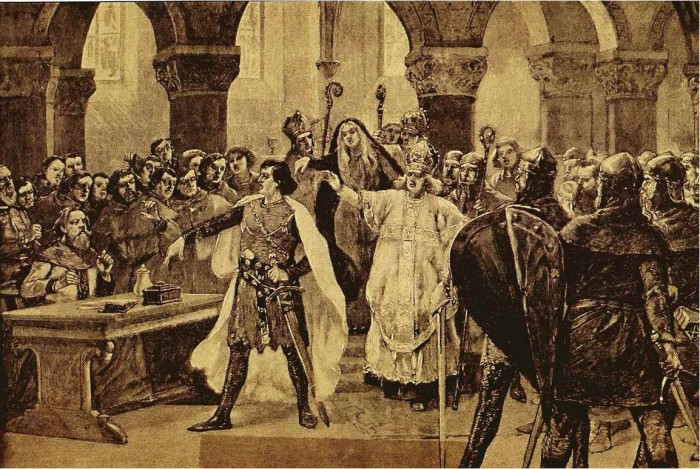
Pope
Gregory VII excommunicating Holy Roman Emperor Henry IV
|
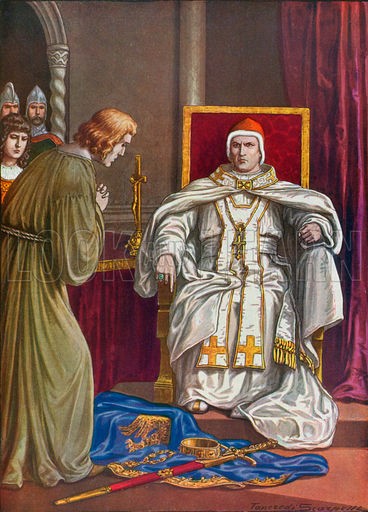 |
After much
bluster on both sides, the advantage gradually came
to the side of Gregory VII because the German
princes and the aristocracy saw a great opportunity.
Happy to hear of the king's removal as "Emperor",
they used religious reasons to continue a major
rebellion started in 1075.
This began a
seizure of royal holdings. Aristocrats claimed
local lordships over peasants and property, built
forts (which had previously been outlawed) and built
up localized fiefdoms to secure their autonomy from
the empire.
Seeing his
empire disintegrate, Henry IV had no choice but to
back down. He needed time to marshal his
forces to fight the rebellion in his homeland.
So in 1077 Henry IV traveled to Canossa in northern
Italy to meet the Pope and apologize in person.
It was a famous moment because it marked the first
time an Emperor had ever given in to the authority
of the Pope.
By pitting the
nobility against the King/Emperor, Gregory had
finally found a way to check the previously
undisputed control of the Emperor. Emperor Henry IV
had been one of the most powerful men in Europe.
Now he was forced to spend the rest of his life
dealing with people who were suddenly willing to
give him problems.
Amazingly, the
Church had finally gained the upper hand.
However, the fight wasn't over. The conflict
between Emperor Henry IV and Pope Gregory VII was
only the early part of the Investiture Controversy.
That controversy would be continued by later kings,
emperors, and popes for several centuries.
|
| |
Frederick Barbarossa
|
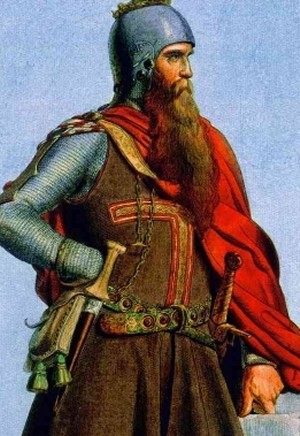 |
When Frederick I (1122-1190),
previously Frederick Barbarossa of
Hohenstaufen, was chosen as king in 1152,
royal power had been in effective abeyance
to a considerable degree for more than
eighty years. The Germany that
Frederick had inherited was a patchwork of
more than 1600 individual states, each with
its own prince. A few of these states such
as Bavaria and Saxony were large, but many
were too small to even pinpoint on a map.
This
ridiculous situation was a direct
consequence of the fight between Henry IV
and Pope Gregory. The reigns of
Henry IV and and his son Henry V
left the status of the German empire in
complete disarray, its power waning under
the weight of the Investiture Controversy.
The
German monarchy had become a nominal title
with no real power. The king was chosen by
the princes, he was given no resources
outside those of his own duchy, and he was
prevented from exercising any real authority
or leadership in the realm.
Once
the supreme authority of the German King/
Holy Roman Emperor had been shattered, the
various princes and nobles began to fight
amongst themselves as well as prey upon the
weak. They seized every chance they
could to grab new chunks of land. As
civil wars broke out throughout the land,
Germany became increasingly subdivided.
The
Germany Frederick Barbarossa inherited was
in a state of constant civil war.
Frederick made it his goal to put an end to
this fighting. However, it wouldn't be
easy. The German princes, far from being
subordinated to royal control, were
intensifying their hold on wealth and power
in Germany and entrenching their positions.
|
When Frederick came to the throne, the
prospects for the revival of German imperial
power were extremely thin. The great German
princes had increased their power and land
holdings. The king had been left with only
the traditional family domains and a vestige
of power over the bishops and abbeys. The
backwash of the Investiture controversy had
left the German states in continuous
turmoil. Rival states were in perpetual war.
These conditions allowed Frederick to be an
occasional peace-maker.
Interestingly, Barbarossa did not use force
to end the fighting, but rather diplomacy.
Frederick was a pragmatist who dealt with
the princes by finding areas of mutual
self-interest. Using his natural gifts
of mediation and his family ties, Barbarossa
was able to unite the various warring
Germanic factions and create peace.
To be
able to patch Germany back together again
simply through the force of his own
personality was asking a bit much, but
Barbarossa was largely successful.
Frederick's charisma led to a fantastic
juggling act in which he settled squabble
after squabble mainly through negotiation.
Working his magic over a quarter of a
century, Frederick restored the imperial
authority in the German states.
That
said, in the end, Frederick failed to
achieve his dream of a Central European
Empire. He really never had a chance -
his enemies were far too formidable to force
them to actually unite, especially with the
Pope constantly using his tricks to turn
various Princes against Barbarossa. But at least
Frederick was able to get the various powers
to cooperate and stop fighting.
Therefore Frederick left behind a legacy of
a strong ruler who was able to create peace.
Frederick II, Barbarossa's grandson, did a
good job of continuing the balancing act.
By playing the various German states against
each other, the lions stayed largely in
check. The 100 year period of the two
Fredericks was largely a time of peace in
the German realm.
This
changed abruptly after the death of
Friedrich II. Germany again plunged
into civil war when Frederick's Hohenstaufen
rule ended. The sovereign rulers of the
empire's various regions began anew to
quarrel over property rights and there was
no one to mediate. Thanks to constant
war, the economy and culture of the area
lagged greatly behind the rest of Europe. Then
came the worst curse of all when the Black
Death pandemic swept through Europe.
In some areas, up to one-third of the
population died off.
On the
surface, it appeared the Church had won the
long struggle. However, from this point on,
the Church overplayed its hand. The people
of Europe watched as one pope after another
used his office for political reasons rather
than spiritual reasons. As a result,
confidence in the position of the pope
declined steadily over time. The constant
involvement of various popes in worldly
matters sowed the seeds of rebellion against
the authority of the Church.
With
the passing of Frederick Barbarossa and his
grandson, Germany lay shattered. Germany would remain in pieces for
another 600 years.
During
these harsh times, the constant suffering
created a longing among the people for the
days of the bygone dynasty and the great
red-bearded leader. After a few centuries of
passing on his legend by word of mouth,
Frederick I became commonly known as "Barbarossa".
By the 16th century the legend of "Barbarossa"
had become quite elaborate, quite possibly
outstripping the man's actual
accomplishments. The name
"Barbarossa" had become the symbol of the general
population's growing desire for a united Germany.
The Barbarossa cult became even more
pronounced in the late 19th century.
William I, the eventual founder of the
German Empire, is said to have benefited
greatly from the legacy of Frederick
Barbarossa.
|
|
|
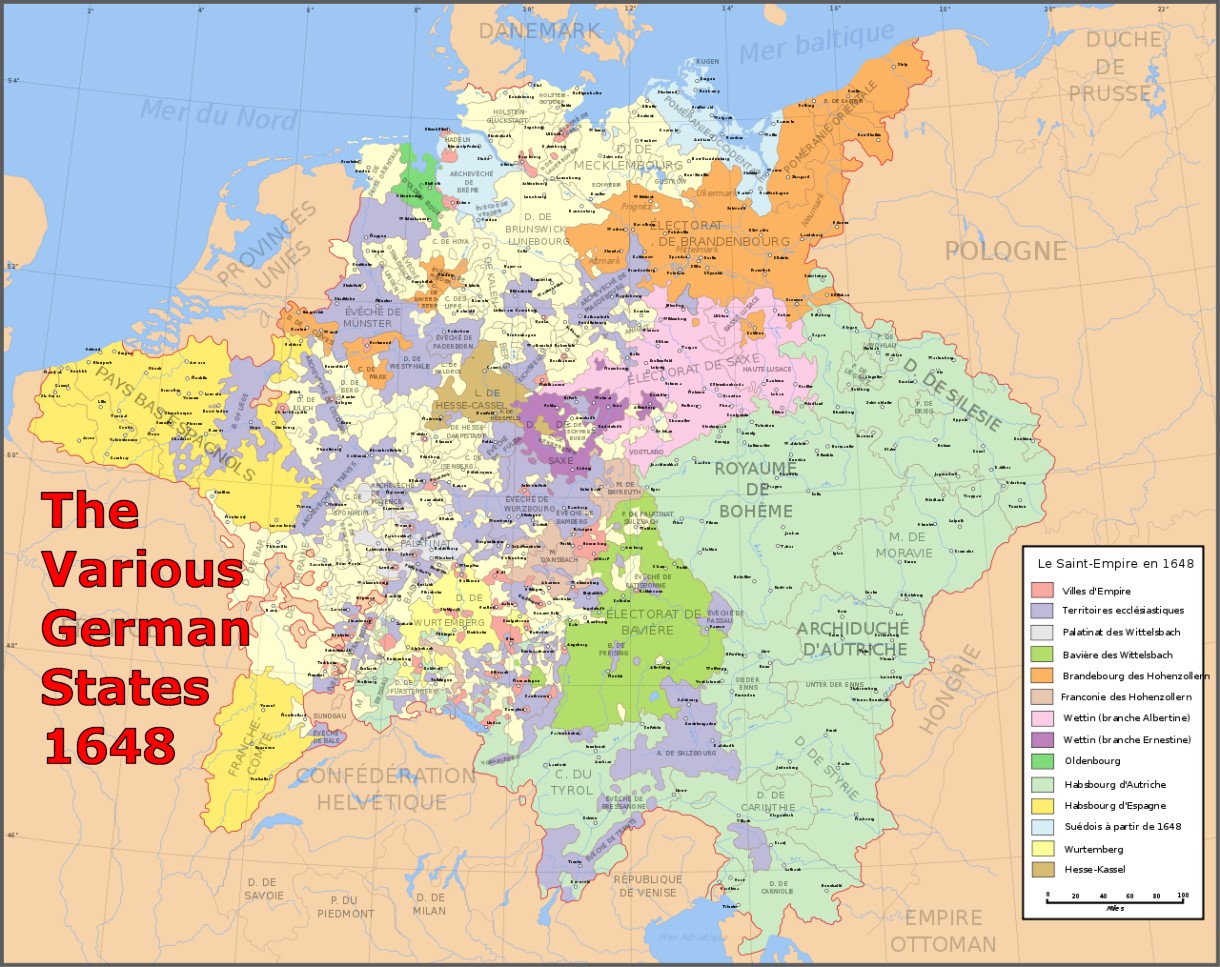
The Germany of
Frederick Barbarossa's day (1152) was said to be divided into 1600
individual states. This 1648 map suggests that Germany
continues to be subdivided into a vast number of separate entities
that are basically independent nation-states.
Take note that
much of Germany belonged to the Church. All those "territoires
ecclesiastiques" colored in mauve are church property.
Also note that
these small, divided nation states are ripe for conquest by the larger states
surrounding them such as Austria, Poland, France, Denmark, and
Sweden. Divided Germany was something of a sitting duck.
Patchwork Germany
|
What a mess. Back in the days of Otto I, no one ever
foresaw these problems. From Otto's point of view, the
Emperor would always be in charge. However, the fact
that the seat of King/Emperor was an elected position became
an Achilles Heel.
Once Pope Gregory began the process of
eroding the Emperor's power, Frederick Barbarossa was the
last man to effectively challenge the Papal authority.
Once he was gone, the next 600 years of Emperors were all severely restricted by the
near-equal power of the various
Prince Electors. At no time could the Emperor simply
issue decrees and govern autonomously over the Empire.
The Emperor always had to answer to the German Princes.
From the High Middle Ages onwards, the
HRE was marked
by an uneasy coexistence of meddling popes and the princes of the local
territories who were always looking for ways to take power away from the
Emperor.
To a greater extent than in other medieval kingdoms such as
France and England, the Emperors were unable to gain much
control over the lands they 'formally owned', but were ruled
over by other leaders such as the Princes.
Furthermore, since the King and Emperor positions were "elected",
the Emperors were vulnerable to being voted out.
This
was crippling.
Now instead of consolidating the far-flung territories into a cohesive unit, Emperors were forced to grant more and
more autonomy to princes, nobles and bishops to
secure their position from a threat of being deposed.
|
This process had begun in the 11th century with the
Investiture Controversy. From that point on, each Emperor
struggled to regain the upper hand, but were thwarted both by
the papacy and by the princes of the Empire.
Germany began as an assemblage of a number of once separate
and independent people and kingdoms known as duchies.
When Louis the German took over East Francia in 843
after the Treaty of Verdun, the
area was subdivided into several sub-kingdoms known as "Stem
Duchies".
These duchies were essentially the
domains of the old Germanic tribes of the area that had
first settled there such as the Saxons (Saxony).
Bavaria was another stem duchy. Bavaria is one
of the oldest continuously existing states in Europe. It was
established as a stem duchy in the year 907. In the
17th century, the Duke of Bavaria became a Prince-elector of
the Holy Roman Empire of the German Nation.
Within the large stem duchies, there were also hundreds of
small, German-speaking principalities. For example,
modern Bavaria includes parts of the historical regions of
Franconia, Upper Palatinate and Swabia.
These were all independent nation-states at some point in
time.
Oddly enough, medieval England and France once
looked the same way. They were just as divided as
Germany.
However, while England
and France used the power of the throne to become unified into
large, coherent
nations with central authority, the German lands remained
separate.
We have seen the difference boiled down to the weakness of the
Emperor.
He could be voted out of office. He couldn't
tell the princes what to do with their own lands.
At various points during the 800 years of the HRE, the
Emperor was more cheerleader than actual leader, more puppet
than potentate. He was forced to watch helplessly as
his "Empire" became increasingly chopped into bits and
pieces.
In the end, the problems in Germany could be attributed
directly to the constant interference of the Church and the
manipulation of the German princes.
Once the Church undermined the authority of the Emperor
starting with Henry IV, the princes became the real power.
Lacking any central authority, the inmates ruled the asylum.
The constant civil wars kept Germany separated.
Another problem was a process known as feudal fragmentation. Each
German nation-state had significant autonomy to the point
of outright independence. Each state was ruled by a high-ranking
noble such as a prince or a duke.
Feudal fragmentation occurs after the death of the
legitimate ruler who
leaves no clear heir. Fragmentation also occurs when the legitimate rule subdivides his
territory to several heirs.
Besides the large stem duchies, within them were hundreds of
small, German-speaking principalities, most of which derived
from successive dynastic splits.
Due to this bizarre system, other than war, the fast way to
grow a dynasty and acquire land was to MARRY someone else
with land and merge the territories.
Principalities were sometimes united through royal
marriages, but the resulting entity was often not a
contiguous territory. Princes might control two or
three
territories hundreds of miles apart.
The number of territories in the Empire was considerable,
rising to approximately 300 at the time of the 1648 Peace of
Westphalia. Many of these Kleinstaaten ("little states")
covered no more than a few square miles, or included several
non-contiguous pieces. The Empire was called a Flickenteppich ("patchwork carpet").
Over time, these small states modernized their military,
judicial, and economic administrations. These
institutions hardly existed
at the imperial level. The emperor was little more
than a feudalistic figurehead, a man without political or
military clout.
Many of the princes had better armies than the emperor.
This was by design; the princes did not wish to give up
control to a central leader.
If anyone had given this
any thought, they would see the lack of centralized
authority meant German lands were ripe for invasion.
United we stand, divided we fall.
Never in their wildest dreams
did the princes guess
their own Emperor would do something so stupid as to cripple
the Kingdom of Germany for the next two centuries.
|

1789
was the year of the French Revolution. As this map
indicates, over the past eight centuries, German territory
had been sliced and diced into something resembling Swiss
Cheese.
Estimates of the total number of German states at any given
time during the 18th century varies range from 294 to 348
separate nation-states. This crazy map gives a good idea
of just how fragmented Germany had become.
Although we are jumping ahead somewhat, note that the
important nation state of
Saxony
was now in the Habsburg Austrian domain. In the 18th
and 19th century, Austria was the dominant power. And
notice how large
Brandenburg
has become.
Below is the same
map enlarged.
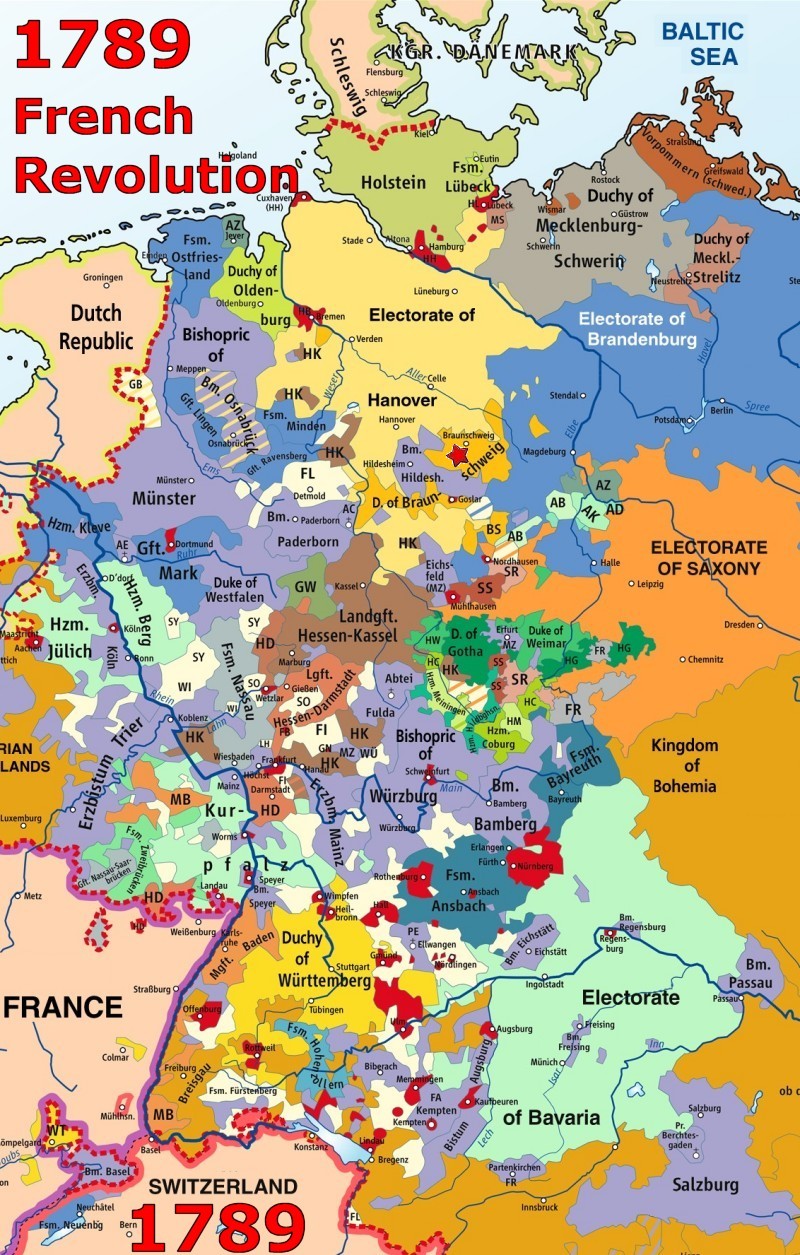
In the
summer of 1789, young Wilhelm von Humboldt and some friends,
left Brunswick, capital of the Duchy of Brunswick-Wolfenbüttel,
for France to observe the revolutionary events unfolding in
Paris.
Von
Humboldt wrote that he would need to enter and exit six duchies,
four bishoprics (land owned by the Church) and one Free Imperial City (Aachen) simply
to reach the French border.
See how long it takes you
to locate the
red star
on the map which marks his home
territory (Braunschweig). The struggle to locate the
red star will reflect
the absurdity of how complicated this map is.
|
Martin
Luther
|
One of the most important figures in European history was
Martin Luther. Martin Luther changed the world.
He also unwittingly got a lot of people killed in the
process.
Martin Luther (1483 - 1546) was a German monk, Catholic
priest, and professor of theology. Luther became the key figure
of a reform movement in 16th century Christianity known as the
Protestant Reformation.
The Investiture Controversy had reversed the abuses of
State power under "simony", the practice of selling high
church offices against the will of the church.
However, once the Church had the upper hand, the Church had begun to
abuse its own power as well. The Church had begun selling places in
Heaven!!
Current Roman Catholic theology stated that faith alone
could not guarantee man's place in Heaven. Justification
depended on charity and good works. The benefits of
good works could be obtained most easily by donating money
to the church. Luther didn't agree.
On 31 October 1517, Luther wrote to his bishop, Albert of
Mainz, protesting the sale of indulgences.
Among Luther's points was Thesis 86 which asked: "Why
does the pope, whose wealth today is greater than the wealth
of the richest Crassus, build the basilica of St. Peter with
the money of poor believers rather than with his own money?"
Luther also objected to a saying attributed to Johann Tetzel
that "As soon as the coin in the coffer rings, the soul
from purgatory springs into heaven".
Luther insisted that forgiveness was God's alone to grant.
He added those who claimed that indulgences absolved
buyers from all punishments and granted them salvation were
in error. Christians, he said, must not slacken in following
Christ on account of such false assurances.
Luther strongly disputed the claim that freedom from God's
punishment for sin could be purchased with monetary values.
Luther taught that salvation and subsequently eternity in
heaven is not earned by good deeds but is received only as a
free gift of God's grace through faith in Jesus Christ as
redeemer from sin.
|
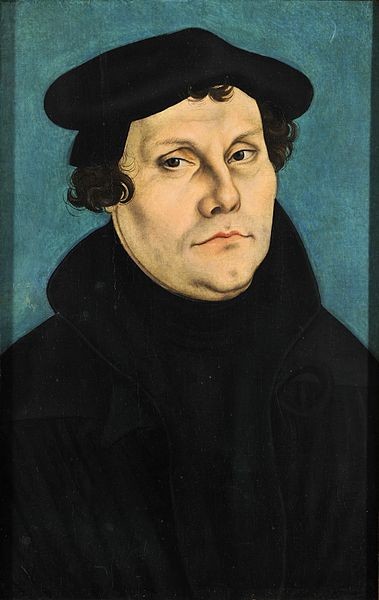 |
It should be no
surprise to learn that Luther had made a powerful
enemy. The Pope was incensed.
Luther's theology
had directly challenged the authority of the Pope of the
Roman Catholic Church by teaching that the Bible is the only
source of divinely revealed knowledge from God.
In 1520 Pope Leo X demanded Luther retract all of his
writings. Luther's refusal resulted in his excommunication
by the Pope.
Holy Roman
Emperor Charles V took note. This was his chance to protect the Church and the Papacy.
Charles
summoned Luther to a meeting to renounce or reaffirm his
views.
|
At the Imperial Diet of Worms on 28 January 1521,
Luther gave a brilliant defense of his ideas. His
presentation was so powerful that several leaders in the
audience were shocked to realize his ideas made actually sense.
They also could not believe the Church had been stupid enough to
give this brilliant man an open forum for his ideas.
It was common
knowledge that Luther's fate had been sealed long before this meeting even took place.
Luther was
surely a dead man. But maybe not.
Over the next five days, private
conferences were held to determine Luther's fate. Then
came the verdict.
The Emperor declared Luther an
outlaw, banned his literature, and ordered his arrest.
"We want Luther to be apprehended and punished as a notorious
heretic."
|
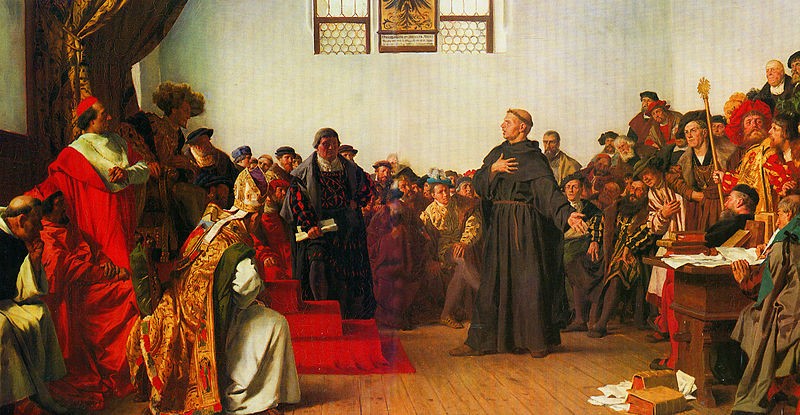
Martin Luther gives a brilliant explanation of his
ideas at the 1521 Diet of Worms
|
The problem was that Luther had
disappeared.
Now they had to find him. The verdict made it a crime for anyone in
Germany to give Luther food or shelter; it also permitted
anyone to kill Luther without legal consequence.
About the same
time as the verdict
was being read, Luther had been on the road walking home.
To his shock, he was accosted by masked horsemen who
insisted he come with them against his will.
As Luther would learn, it was all an act.
Prince Frederick, Duke of Saxony, had decided to
"kidnap" Luther for his own good. He made his
men appear as armed highwaymen to disguise his
involvement. In reality Frederick
was taking steps to protect Luther from certain
death. It was a brilliant move.
While in
captivity, Luther would write a German version of
the Bible. He would soon form his own Lutheran church
which led to the Protestant Reformation.
Centuries of
resentment towards the Catholic Church and its
abuses resulted in mass defections. Now that
people had a CHOICE of religion,
countless Protestant churches began to appear across
Germany. Overnight this new
religion would create a huge schism within Western Christianity.
Soon this schism would lead to the terrible European wars of
religion.
Martin Luther
had unwittingly brought the equivalent of a Biblical
Plague right to the doorstep of Germany. 7
million people were doomed to die in the religious
wars that would soon follow.
|
|
1618-1648: The Thirty Years
War
|
As if Germany didn't have enough problems already,
Germany was now further subdivided along religious lines. Martin Luther's Reformation in 1517 pitted the
religious beliefs of Catholics versus Protestants.
Germany had hundreds of rulers, some of them famous, most of
them forgotten. Every one of the rulers was either important or thought he was
important.
They wanted control and greatly resisted
external authority. They invariably coveted the lands of their
neighbors, but now they had a new excuse to fight:
Religion!!
The Reformation meant that many states within the
Catholic HRE
had suddenly become Protestant instead. The backlash was
predictable. Catholic rulers decided they had the God-given right to change the religion of their
neighbors by force.
The concept of religious tolerance simply did not exist back
in those times. Over the next century, states headed
by Roman Catholic dynasties faced those ruled by Protestant
dynasties in a seemingly neverending series of religious conflicts.
As far as Dynasties were concerned, there was one dynasty
that stood out above all others - the Roman Catholic Habsburg Family.
They controlled territory in Spain, Netherlands, Italy,
Germany, Austria, Hungary, and Bohemia.
The power base of the
Habsburg family had begun in Switzerland in the 1000s.
From there, the family had moved its power base to the Duchy
of Austria. Each century marked new acquisitions of
land.
At times the family used force to expand its territory, but
mainly it used a series of dynastic marriages to vastly
expand its domains. By marrying the rich to the rich
and rulers to the rulers, Burgundy, Spain, Hungary, Bohemia, and other territories
all came by inheritance.
The House of Habsburg produced
kings of various Dutch and Italian countries, Spain, Bohemia, England, Germany, Hungary, Croatia,
Ireland, and Portugal.
The throne of the HRE was continuously occupied by
the Habsburgs between 1438 and 1740.
The most powerful Habsburg of all was Charles V.
Under Charles, the Habsburg dynasty
achieved the position of being a true world power.
Charles was unhappy that there were holes separating his
various territories. It was his ambition to see an
unbroken empire across the continent. He came close. Charles stretched the House of Habsburg so far across Europe
that he was said to rule "the empire on which the sun never
sets".
Charles V was best known for his constant battles with the
Ottoman Empire (Turkey), but in his spare time as Holy Roman
Emperor, Charles was also the man who organized the initial
counter-attack to the Protestant Reformation.
However, it would be left to Ferdinand, brother of
Charles V, who caused the greatest war in European
history to date.
The Thirty Years War (1618-48) began when Holy Roman
Emperor Ferdinand II of Bohemia attempted to curtail
the religious activities of his subjects.
One needs to remember the duty of the Holy Roman Emperor is
to protect the Catholic Church. Ferdinand II assumed
he had the right to tell his people which religion they
should choose "or else".
This of course sparked rebellion among the Protestants of
the realm.
During the 16th century, the Reformation and the Counter
Reformation had divided all of Germany into hostile Protestant and
Catholic camps, each prepared to seek foreign support to
guarantee its integrity if need arose. Well, the need
arose.
In 1618, when Ferdinand II used his authority as the
Holy Roman Emperor to curtail certain
religious privileges enjoyed by his subjects, they
immediately appealed for aid to Protestants in the rest
of the empire and to the leading foreign Protestant states:
Great Britain, the Dutch Republic, and
Denmark.
Ferdinand now called upon the German Catholics (led
by Bavaria), Spain, and the papacy to send
armies in support.
Not surprisingly,
Ferdinand's coalition known as the Imperial Army
dominated Phase I and Phase II of the ensuing war.
Ferdinand and his allies won a major victory at White
Mountain (1620) outside Prague thanks to the Imperial armies
commanded by Albrecht von
Wallenstein. This victory was so complete that let
to the extirpation (extinction)
of Protestantism in most of the Hapsburg lands (Austria,
Bohemia).
Encouraged by his success, Ferdinand turned in 1621 against
Bohemia’s Protestant supporters in Germany. Despite aid from
Britain, Denmark, and the Dutch Republic, the Protestants lost
again.
In 1629, imperial armies commanded by Albrecht von
Wallenstein, a brilliant Bohemian military leader, overran
most of Protestant Germany and much of Denmark.
Ferdinand assumed he had won. He then issued the Edict of Restitution,
reclaiming lands in the empire belonging to the Catholic
Church that had been acquired and secularized by Protestant
rulers.
One of the interesting stories throughout the war involved
Wallenstein. This talented general had never
been defeated in a major battle. However he was
released from service in August 1630 after Ferdinand grew
wary of his ambition.
Immediately the Protestants began to win. Several
Protestant victories over Catholic armies induced Ferdinand
to recall Wallenstein, who again turned the war in
favor of the Imperial cause.
However, Emperor Ferdinand dismissed him for the second time out of
fear that Wallenstein was becoming too powerful.
Dissatisfied with the Emperor's treatment, Wallenstein
considered allying with the Protestants. However, he
was assassinated at Cheb in Bohemia by one of the
army's officials, Walter Devereux, acting with Emperor
Ferdinand's approval.
Had Wallenstein lived, Europe's map might look very
different today. Instead, with Wallenstein out
of the picture, the Protestants made a comeback.
It took Swedish military aid to save the Protestant cause.
In 1630 an army led by Gustavus Adolphus landed
in Germany.
Thanks to a subsidy from the French
government and assistance from many German Protestant
states, Adolphus routed the Imperialists at Breitenfeld
(1631) and drove them from Germany.
The Protestant revival continued until 1634. A Spanish
army raised by the Habsburgs intervened at Nordlingen to defeat the main
Swedish army and force the Protestants out of southern
Germany.
This new Hapsburg success had an unexpected consequence.
France had played only a support role till now. But
the growing power of the Habsburg family created a fear of
encirclement - Spain, Austria, and Germany were threats.
It was time to ensure that Germany stayed out of Habsburg
hands
France declared war first on Habsburg Spain (1635) and then
on Ferdinand, the Habsburg HRE emperor (1636).
Previously the war had been fought principally by German
states with foreign assistance throughout the 1620s.
With the entrance of France, now this war escalated to
become a struggle among the great powers - Sweden, France,
Spain, and Austria. Suddenly major campaigns involving
countless thousands of troops were fought largely on German soil.
What had started out as a localized battle suddenly became
the most brutal and all-encompassing war Europe had ever
seen.
For the next 12 years, 500 armies
maneuvered for supremacy in every corner of German
territory.
These armies carried out a
“dirty war”. The destruction caused by mercenary
soldiers defied description. Even if something wasn't valuable to them,
they destroyed it anyway if it might be of possible use to the enemy.
Horrible atrocities were committed
that came close to being flat out genocide.
For example, in Protestant Magdeburg, once the Imperial soldiers broke through
after a long siege, they lost
control.
The invading soldiers had not received payment for their
service. Now they took the chance to loot everything in sight;
they demanded valuables from every household that they
encountered.
Otto von Guericke, an inhabitant of Magdeburg, claimed that
when civilians ran out of things to give the soldiers, "the
misery really began. For then the soldiers began to beat,
frighten, and threaten to shoot, skewer, or hang the
people."
The attackers set fire to the city and started to massacre the inhabitants.
It took only one day for all of this destruction and death
to transpire. Of the 30,000 citizens, only 5,000 survived.
Eventually the war came to end. It was France's
intervention that brought things back under control.
France’s victory over the Spaniards at
Rocroi
(1643) and Sweden’s defeat of the Imperialists at Jankau
(1645) forced the Hapsburgs to make concessions that led to
the Peace of Westphalia in 1648.
What had started as a religious war ended as a war between
states.
The Habsburgs were well on their way
to victory till Roman Catholic
France and Orthodox Catholic Russia intervened. So much for
religious differences.
The irony was obvious. What had started as
a war of religion ended as a World War where religion no
longer mattered.
If anything good came of the Thirty Years War, it was
that people became much more accepting of religious
differences. What a shame it was that 7 million people
had to die so the living could figure it out.
Along the way, the Holy Roman Empire lost much of what
remained of its power. It would never again be a
significant actor on the international stage again.
The Habsburgs would continue to be crowned kings and emperors, but
their strength would derive from their family holdings, not
as leaders of the HRE.
|

Map of the Habsburg Family Dynasty. This is "the
empire on which the sun never sets."
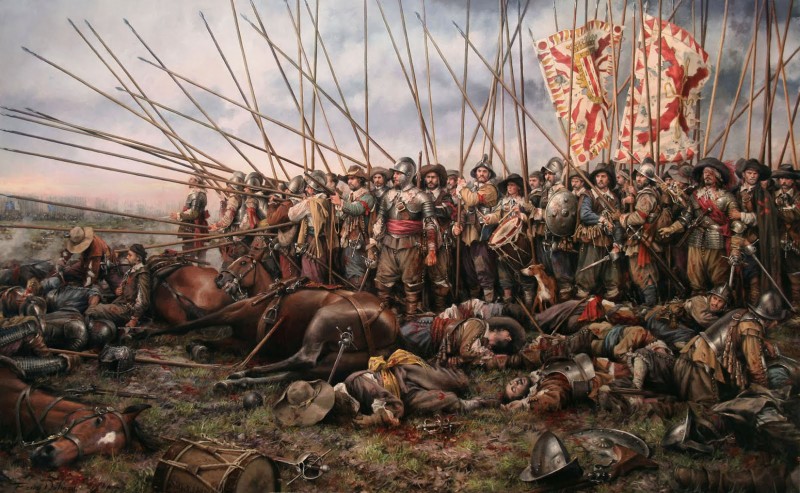
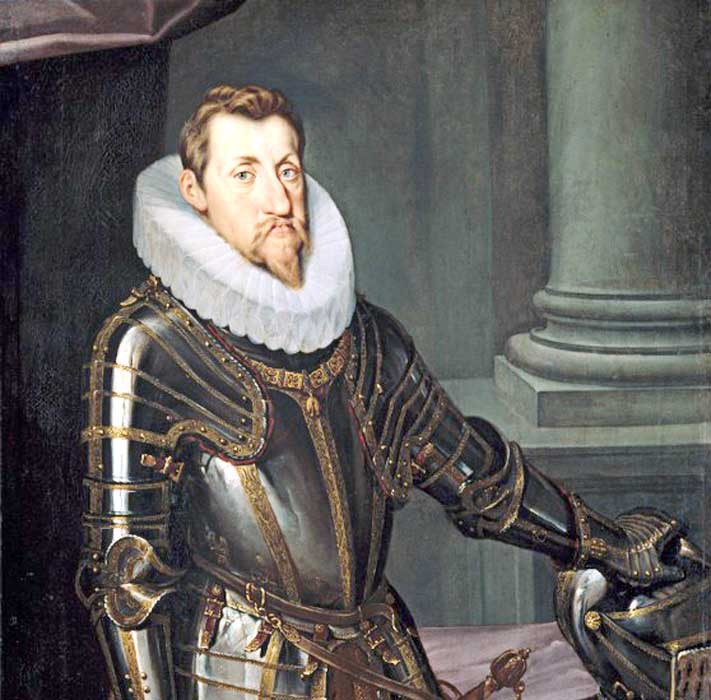
Holy
Roman Emperor Ferdinand II, responsible for sparking a war
that killed 7.5 million people, most of whom were civilians.
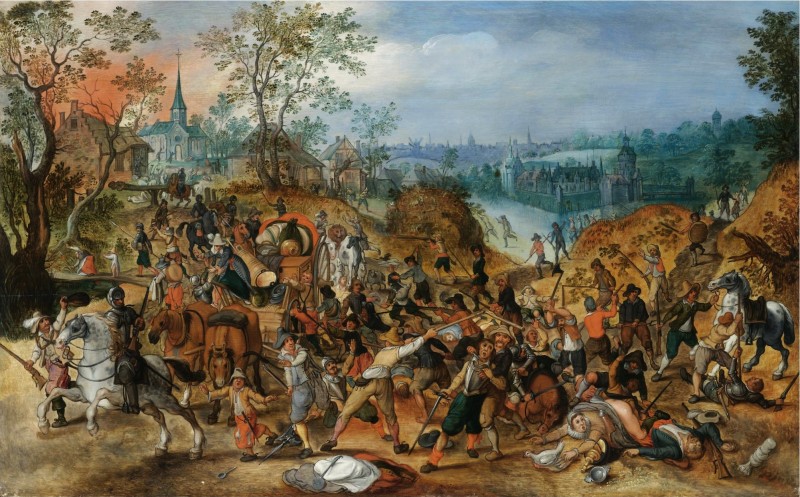
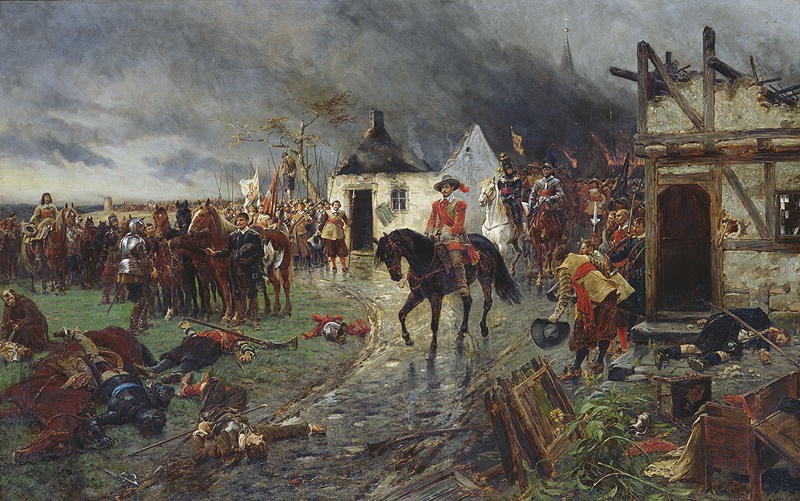
Albrecht von Wallenstein
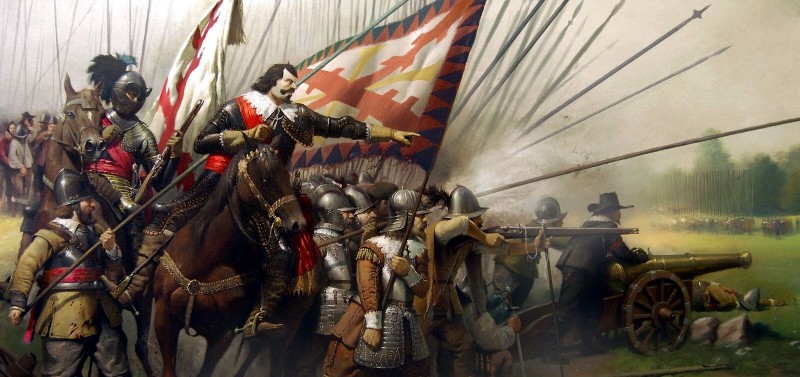
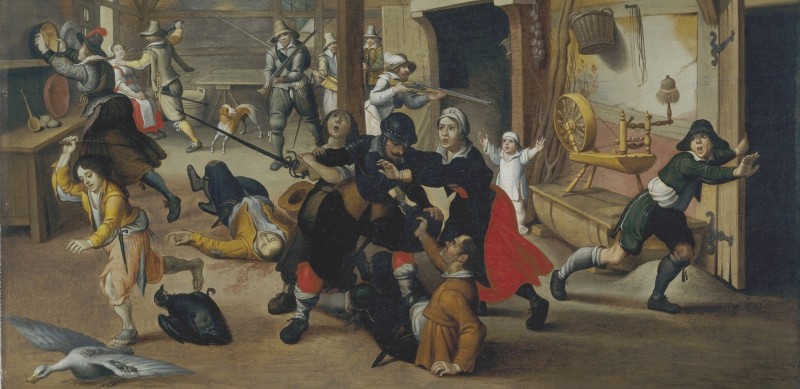
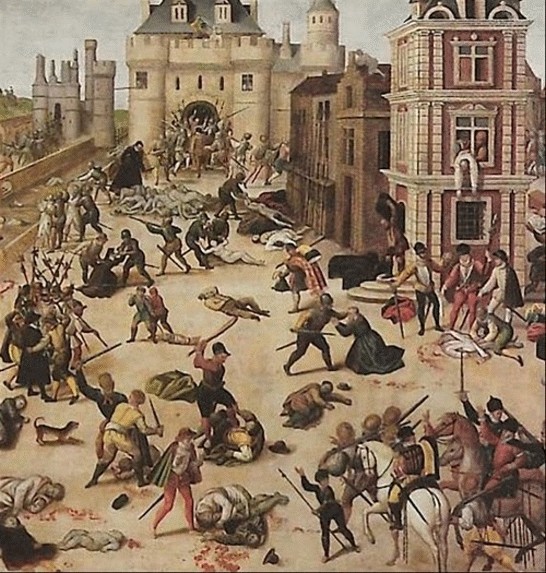
The
Massacre of Magdeburg in 1630 convinced many Protestant
rulers in the Holy Roman Empire to join Sweden's Adolphus
and take a stand against the Catholic emperor.
It
also printed on Protestant minds the indelible conviction
that Catholicism was a bloody and treacherous religion.
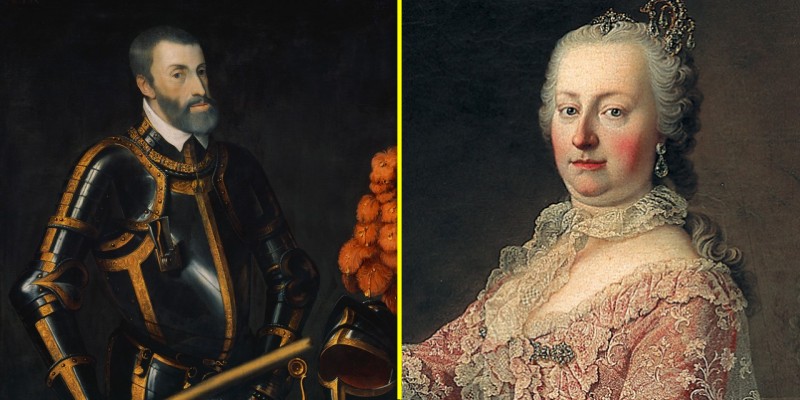
Charles V and Maria Theresa.
The secret weapon of
the Habsburg Family was their uncanny knack to have members
intermarry into other royal houses in order to build
alliances and inherit territory. Empress Maria Theresa is
recognized quite notably for it; she is referred to as the
"Great-Grandmother of Europe". For example, Marie
Antoinette was the fifteenth of sixteen children of Holy
Roman Empress Maria Theresa and Emperor Francis I.
The political side of the Habsburg dynasty ended with World
War I. However the family itself came to an end in a very
strange way. The Habsburgs sought to consolidate their
power by the use of frequent marriages within their own
family. Marriages between first cousins, or between uncles
and nieces, were commonplace in the family. If one married
"inside the family", one did not have to divide and share
the land with another family.
This
tactic was successful in keeping the vast lands to
themselves, but it backfired in a strange way.
Over time this practice resulted in a cumulatively
deleterious effect on their gene pool. A study of 3,000
family members over 16 generations suggests that inbreeding
led directly to their extinction. The gene pool eventually
became so small that the last of the Spanish line Charles
II, who was severely disabled from birth, perhaps by genetic
disorders, possessed a genome comparable to that of a child
born to a brother and sister, as did his father, likely due
to "remote inbreeding".
|
The 1648 Peace of Westphalia largely settled German affairs
for the next two centuries. It ended religious conflicts
between the states and included official recognition of
Calvinism.
The document altered the boundaries of the HRE by
recognizing Switzerland and the Netherlands had become
sovereign states outside the empire.
Germany itself was absolutely devastated. This war constituted the
worst catastrophe ever to afflict Germany to date.
Anywhere from 25%
to 40% of the overall population in the area was dead.
Half the men in Germany were dead. It would take a century
to replace the fallen.
The scorched earth policies had leveled entire villages. Castles were destroyed,
cities were ruined, farmlands and forests had been burned to
the ground.
Germany's economy was severely disrupted by the ravages of
the Thirty Years' War. The war created an economic decline
as the European economy shifted westward to the Atlantic states
- France, England, Spain, Netherlands and Belgium.
Germany had been disunited throughout its history, but it
had at least been prosperous. Its people were
industrious and diligent. Using its location at the center of Europe
and the Baltic Sea, the Germans had been leaders for
centuries in the Hanseatic League, a vitally important
commercial confederation.
That was all over. The shift in trade meant that
Germany was no longer located at the center of European
commerce but rather on its fringes. The Hansa towns in the
north became completely dominated by the Dutch.
The thriving economies of many German towns in the late
Middle Ages gradually dried up thanks to the long war. Germany
would now enter a long
period of economic stagnation that would extend over the
next two
hundred years.
The real change in Germany was the loss of morale. For
30 years, German states had waged war on other German states
in what amounted to a German "Civil War". Germans had
fought Germans. The country had been ripped asunder by
religious insanity.
Countless Germans had
been murdered by his fellow man all in the name of God.
Now the hatred and distrust of fellow Germans was intense.
Germany was split into 300 jigsaw pieces. There was no
recognized leader to pick up the pieces and put Germany back together again.
Ferdinand II, the man
who had caused this plague to begin with, had died in the
middle of the war. Ferdinand III, his son, took his place and made things even
worse. In 1644 during the last stage of the war, Ferdinand III gave the right to rulers of German states
to conduct their own foreign policy.
The emperor was trying to gain more allies in the
negotiations with France and Sweden, but this edict
backfired.
The
main result was the
division of Germany into even more territories —
all of which, despite their membership in the HRE,
won actual sovereignty.
The Holy Roman Empire concept was reduced to ashes. As
if it were possible,
Germany was less united at the end of the war than at the
start.
In a sense, 300 separate countries occupied the space we now call
Germany.
These weren't "colonies" like here in America that had
at least some common association. These 300 countries
all had their own flag, their own hereditary leader, and no
desire at all to be a part of anything bigger.
The survivors just wanted to retreat inside their borders and be
left alone to lick their wounds.
How could anyone ever possibly hope to unite a land as
disorganized as Germany?
|
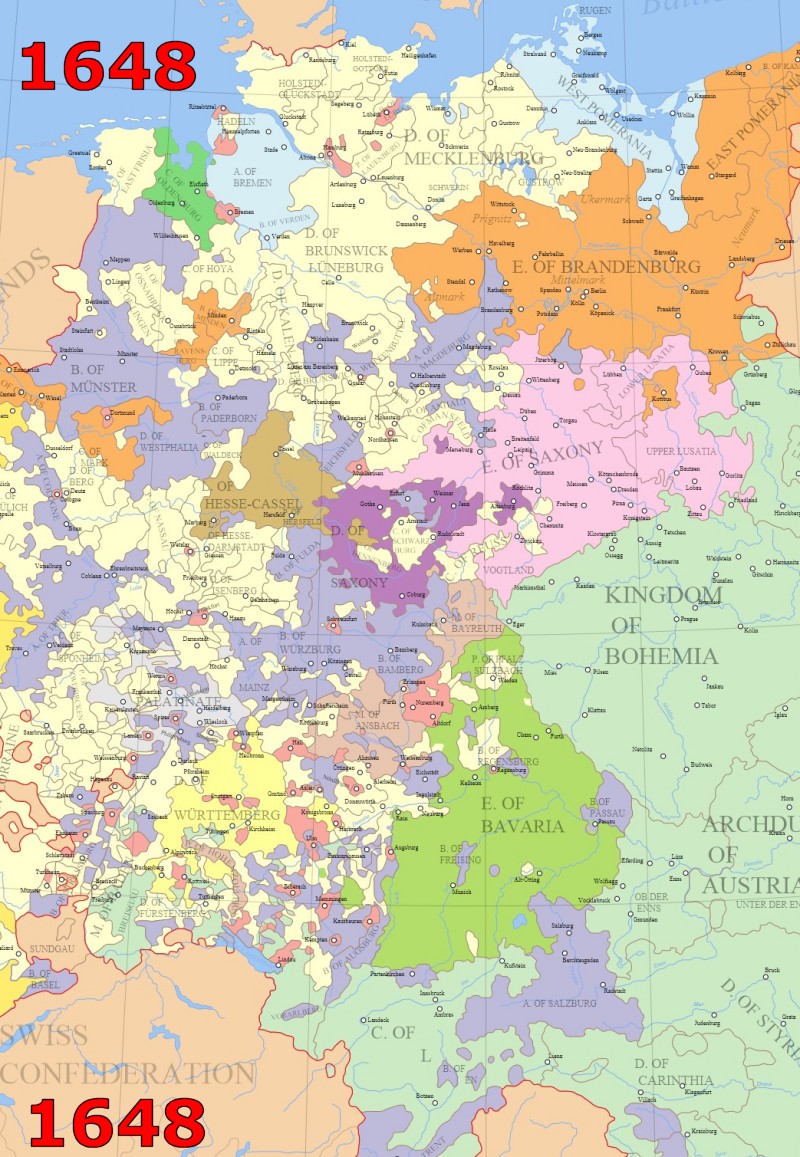
This
map drawn at the end of the Thirty Years War gives another
look at the preposterous patchwork carpet of territories Germany had turned into.
The big winners
of the long war were Switzerland and Netherlands which broke
away from the HRE to become independent nations.

Is
this the strangest map ever? After the Thirty
Years War, the European continent resembled a giant doughnut
with divided Germany forming the massive pockmarked hole in the middle.
So what does this picture mean?
Saxony, Bavaria, and Brandenburg were the only sizeable
areas. In addition, there were roughly 300
small political units inside that Black Hole. Each
unit had its own leader and army. Each unit was strong
enough to withstand each other, but there was no one to
unite the 300 armies against a much larger common enemy.
Austria on the other hand was eying German territory
covetously. And so was somebody else...
|
|